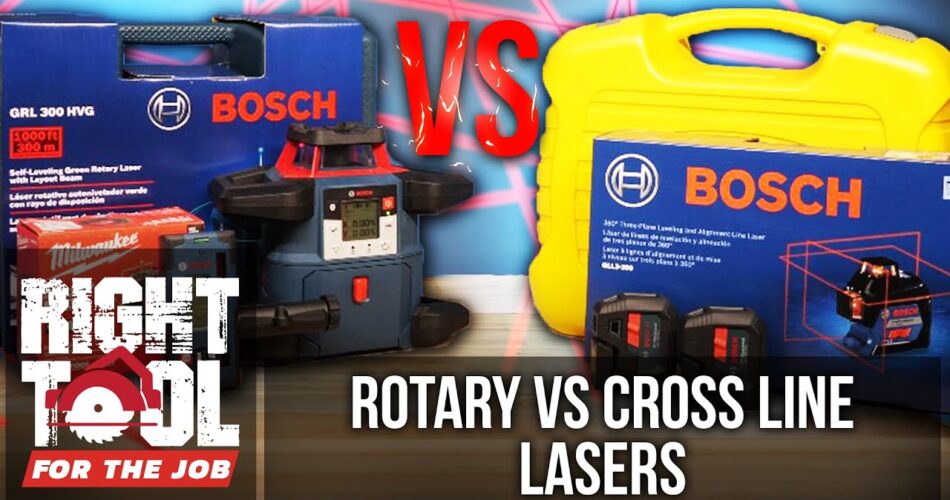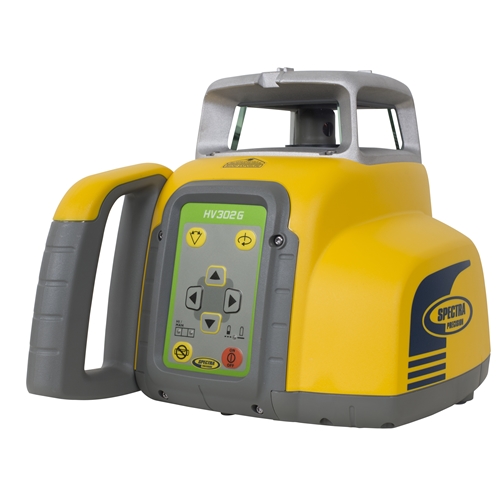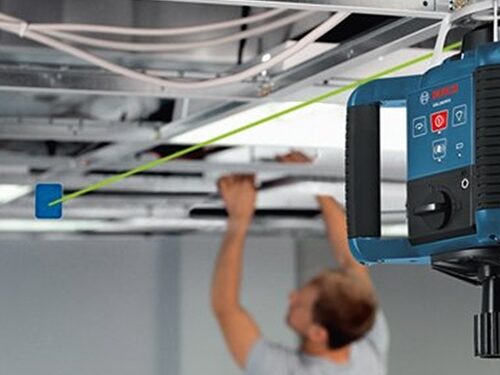Laser levels are a critical tool for various indoor and outdoor applications. Whether you’re working on a major construction task or completing a DIY home project, laser levels make a world of a difference. Rotary lasers and line laser levels will perform differently depending on your environment and intended use, so you should make sure you understand the key differences before purchasing one.
Line Laser Levels
Line lasers project horizontal or vertical lines onto a surface. This type of laser uses a prism to deflect the laser into a solid line either straight forward onto one surface or 360° around a room. These appear brighter because the laser is stationary on the surface, rather than rotating around the room. Cross line lasers work best for interior applications like installing cabinetry, tile, drop ceilings, or for basic levelling, but they can also be used for some outdoor applications like installing a deck, pouring concrete, or site layouts.
Another benefit of line lasers is that they are more affordable than rotary lasers and easier to transport. If you’re working on indoor or close-range jobs, a cross line laser will probably be a better option for you because it has the necessary range and brightness without breaking the bank.
Rotary Lasers
Rotary lasers work by sending out a laser beam through a single point diode. This gives a greater range because the beam is concentrated in one area. These are used in most major construction jobs because of their long range in outdoor applications, making them more visible in bright lighting. Unlike line lasers, rotary lasers rotate 360° around an area rather than staying locked on your target location. The quick, constant rotation of a single laser makes the human eye think that there is one continuous line going around the room. In long-range applications where the laser goes beyond the visible range, you should use a receiver to increase visibility.
Rotary lasers are also very common on jobsites because they are more durable than smaller line lasers. They can easily be mounted onto a tripod to change their perspective and range. You should also take into consideration the RPM of your rotary laser level when using it. Rotary lasers with a low RPM (rotations per minute) are brighter and more visible, but do not have a long range. Likewise, lasers with a higher RPM can reach farther, but they may appear more faintly. Rotary lasers are really only needed for outdoor applications because of their size and range, but if you already own one or are planning on working both indoors and outdoors, certain rotary lasers work well in both situations.
What Do We Recommend?
- Bosch 360 Red Beam 12V Three-Plane Leveling and Alignment-Line Laser (GLL3-300)
- Milwaukee M12 Green Cross Line & Plumb Points Laser (BARE TOOL) (3622-20)
- Bosch Self-Leveling Green-Beam Rotary Laser with Layout Beam (GRL 300 HVG)
- Spectra Precision 2,600 FT. Diameter Self-Leveling Grade Laser w/ Receiver (SPEC-GL412N)
Still have questions about the different laser level options available at Ohio Power Tool? Give us a call at 800-242-4424, email us at sales@ohiopowertool.com, or leave a comment below for assistance. We’re always happy to help! To be the first to know about new products and deals, subscribe to our e-newsletter and follow us on social media!






